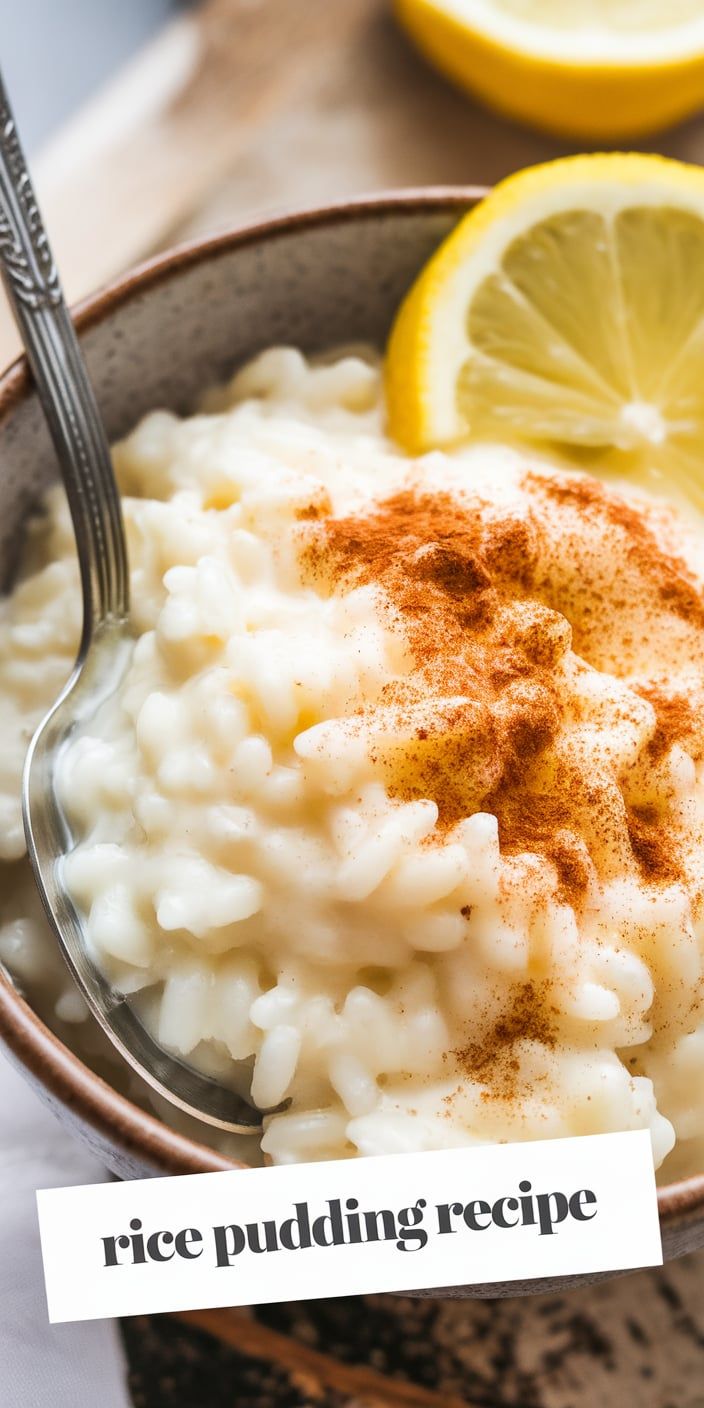Welcome to the ultimate homemade rice pudding recipe that will transport you straight to comfort food heaven! As a passionate home cook, I’ve perfected this creamy dessert that brings warmth and nostalgia to any kitchen. Rice pudding isn’t just a simple dish—it’s a culinary journey of creamy textures and delightful flavors.
My rice pudding recipe combines traditional techniques with a modern twist, making it perfect for anyone craving a delicious homemade treat. Whether you’re a seasoned baker or a kitchen novice, this recipe will guide you through creating a rich, smooth dessert that everyone will love.
In the following sections, I’ll share my tried-and-true method for making the most incredible rice pudding. We’ll explore its history, discuss essential ingredients, and walk through each step to ensure your success. Get ready to discover why this classic creamy dessert has been beloved across generations!

The History and Origins of Traditional Rice Pudding
Rice pudding stands as a delectable journey through culinary history, weaving together flavors and traditions from around the world. This humble dessert has captured hearts across cultures, transforming from a simple grain dish to a beloved comfort food.
The rice pudding history stretches back thousands of years, with roots tracing to ancient civilizations. Early versions of this dish emerged in regions where rice was a staple crop, particularly in Asia and the Middle East.
Ancient Culinary Roots
Cultural rice pudding variations reveal fascinating insights into different societies’ food practices. Ancient recipes showcase how communities transformed basic ingredients into nourishing and delightful desserts.
- Mesopotamian cultures first documented rice-based sweet dishes
- Chinese dynasties developed sophisticated rice dessert techniques
- Persian cuisine introduced complex flavoring methods
Global Culinary Evolution
As trade routes expanded, rice pudding recipes traveled across continents. Each region adapted the dish to local tastes, ingredients, and cooking methods, creating unique interpretations.
American Rice Pudding Traditions
American rice pudding traditions emerged from European immigrant influences. Settlers brought recipes from Denmark, Germany, and England, which blended with local ingredients to create distinctly American versions of this classic dessert.
- New England dairy farms influenced creamy rice pudding styles
- Southern regions added distinctive spices and sweeteners
- Immigrant communities contributed diverse preparation techniques
Essential Ingredients for Perfect Rice Pudding
Creating a delicious rice pudding starts with selecting the right rice pudding ingredients. I’ll walk you through the key components that transform simple ingredients into a creamy, dreamy dessert that will delight your taste buds.
When choosing the best rice for pudding, I recommend these top varieties:
- Arborio rice: Creamy and starchy, perfect for rich puddings
- Short-grain white rice: Traditional choice with excellent texture
- Jasmine rice: Adds a subtle fragrant note to your dessert
For milk for rice pudding, you have several delicious options:
- Whole milk: Provides the richest, creamiest texture
- Half-and-half: Creates an extra luxurious pudding
- Coconut milk: Offers a dairy-free alternative with unique flavor
Beyond rice and milk, you’ll want to gather these essential ingredients:
- Granulated sugar or sweetener
- Vanilla extract
- Pinch of salt
- Optional spices like cinnamon or nutmeg
Pro tip: For dietary restrictions, you can easily substitute ingredients. Almond milk works great for a lighter version, while maple syrup can replace traditional sugar for a more natural sweetness.
Kitchen Tools and Equipment You’ll Need
Preparing delicious rice pudding requires the right rice pudding cookware and baking tools for pudding. I’ll guide you through the essential equipment that will help you create a creamy, delightful dessert with precision and ease.
Essential Cookware for Perfect Rice Pudding
When selecting rice pudding cookware, the most critical item is a heavy-bottomed saucepan. This type of pan ensures even heat distribution and prevents scorching. I recommend a medium-sized pan with thick walls that can maintain consistent temperature throughout the cooking process.
- Heavy-bottomed saucepan (4-6 quart capacity)
- Wooden spoon or silicone spatula for stirring
- Non-stick pot for easier cleanup
Precise Measuring Tools
Accurate measuring for rice pudding is crucial to achieving the perfect texture. Invest in quality measuring tools that will help you maintain the ideal liquid-to-rice ratio.
- Liquid measuring cup with clear markings
- Dry measuring cups for rice and other ingredients
- Digital kitchen scale for precise measurements
Optional Baking Accessories
While not essential, these baking tools for pudding can elevate your rice pudding preparation and presentation:
- Ceramic baking dish for oven-baked variations
- Decorative serving bowls
- Instant-read thermometer
Rice Pudding Recipe: Step-by-Step Instructions
Creating the perfect homemade rice pudding is easier than you might think. I’ll guide you through the rice pudding cooking steps to help you make a delicious dessert that will impress your family and friends.
Before you start, gather all your ingredients and kitchen tools. Learning how to make rice pudding requires patience and attention to detail.
- Rinse 1 cup of medium-grain rice thoroughly under cold water
- Combine rice with 4 cups of whole milk in a heavy-bottomed saucepan
- Add 1/4 cup of sugar and a pinch of salt
- Cook over medium heat, stirring constantly to prevent sticking
- Simmer for 20-25 minutes until rice is tender and mixture thickens
- Remove from heat and stir in 1 teaspoon of vanilla extract
The key to perfect homemade pudding instructions is maintaining a gentle heat and stirring frequently. You’ll want to watch for these visual cues:
- Rice should be soft but not mushy
- Mixture should coat the back of a spoon
- Pudding will continue to thicken as it cools
| Ingredient | Quantity | Purpose |
|---|---|---|
| Medium-grain rice | 1 cup | Creates creamy base |
| Whole milk | 4 cups | Provides richness |
| Sugar | 1/4 cup | Adds sweetness |
| Vanilla extract | 1 tsp | Enhances flavor |
Pro tip: Let your rice pudding cool for 10-15 minutes before serving. This allows the pudding to set and develop a rich, creamy texture that everyone will love.
Tips for Achieving the Perfect Creamy Texture
Creating a luxurious, creamy rice pudding requires more than just following a basic recipe. I’ve discovered several key creamy rice pudding tips that can transform your dessert from ordinary to extraordinary. The secret lies in understanding the nuanced techniques that elevate this classic comfort food.
Achieving the perfect texture is an art form that combines careful ingredient selection and precise cooking methods. Let me share some insider insights that will help you master this delightful dessert.
Selecting the Right Rice
The foundation of a creamy rice pudding starts with choosing the right rice. Not all rice varieties are created equal when it comes to creating that perfect, smooth consistency.
- Arborio rice: Ideal for ultra-creamy results
- Short-grain white rice: Creates a classic texture
- Jasmine rice: Offers a subtle aromatic flavor
- Avoid long-grain rice: Less starch means less creaminess
Mastering the Rice-to-Liquid Ratio
The rice-to-liquid ratio is crucial for achieving that dreamy, creamy consistency. I’ve developed a foolproof guide to help you nail the perfect proportion every time.
| Rice Type | Liquid Ratio | Cooking Time |
|---|---|---|
| Arborio Rice | 1:3.5 | 25-30 minutes |
| Short-Grain White Rice | 1:3 | 20-25 minutes |
| Jasmine Rice | 1:3.25 | 22-27 minutes |
Stirring Techniques for Smooth Perfection
Stirring rice pudding is an art that requires patience and precision. I’ve learned that consistent, gentle stirring prevents scorching and ensures an even, creamy texture.
- Use a wooden spoon or silicone spatula
- Stir every 2-3 minutes
- Scrape the bottom of the pan with each stir
- Maintain medium-low heat
By implementing these creamy rice pudding tips, you’ll create a dessert that’s smooth, rich, and absolutely irresistible. Remember, practice makes perfect, so don’t be discouraged if your first attempt isn’t flawless.
Delicious Variations and Flavor Add-ins
Rice pudding offers a delightful canvas for culinary creativity. With countless rice pudding variations, you can transform this classic dessert into an exciting flavor adventure. I’ll share some of my favorite ways to elevate your pudding with unique add-ins and flavor combinations.
Classic flavored rice pudding starts with simple ingredients that can dramatically change the dessert’s character. Consider these exciting pudding add-ins to spark your imagination:
- Fruit Compotes: Fresh berries, mango, or caramelized apples
- Spice Blends: Cinnamon, cardamom, nutmeg, or vanilla bean
- Nutty Additions: Toasted almonds, pistachios, or coconut flakes
- Chocolate Variations: Dark chocolate shavings or cocoa powder
My favorite rice pudding variations include a tropical twist with coconut milk and fresh pineapple, or a warm autumn version with pumpkin spice and roasted pecans. The key is experimenting with flavors that complement the creamy base of traditional rice pudding.
For those wanting to explore global flavors, try these international-inspired pudding add-ins:
- Middle Eastern: Rosewater and pistachios
- Mexican: Cinnamon and dulce de leche
- Indian: Cardamom and saffron
Remember that the best rice pudding comes from creativity and personal taste. Don’t be afraid to mix unexpected ingredients and discover your signature dessert.
Common Mistakes to Avoid When Making Rice Pudding
Creating the perfect rice pudding can be tricky. I’ve learned several key mistakes that can ruin your delicious dessert. Understanding these rice pudding mistakes will help you become a more confident home cook.
One of the most critical pudding cooking errors involves rice selection. Short-grain rice works best for creamy texture, while long-grain varieties can make your pudding too dry and grainy. Stick to arborio or medium-grain rice for optimal results.
- Using incorrect rice type
- Overlooking proper milk-to-rice ratio
- Cooking at incorrect temperature
- Neglecting constant stirring
Temperature control is crucial in troubleshooting rice pudding. Cooking at high heat can cause scorching and uneven texture. I recommend using low to medium heat and stirring frequently to prevent burning and ensure smooth consistency.
Another common mistake is not understanding liquid absorption. Too much liquid creates runny pudding, while too little results in a stiff, dry dessert. Measure ingredients carefully and adjust liquid gradually during cooking.
Remember that patience is key when making rice pudding. Rushing the process or walking away can lead to disappointing results. Stay attentive, stir consistently, and watch your pudding transform into a creamy, delightful treat.
Storage Tips and Reheating Guidelines
Storing rice pudding properly is key to maintaining its delightful creamy texture. I recommend placing your leftover rice pudding in an airtight container and refrigerating it within two hours of preparation. When storing rice pudding, always use a sealed container to prevent moisture loss and keep the dessert fresh.
Reheating pudding requires a gentle approach to preserve its smooth consistency. I suggest warming your leftover rice pudding in the microwave using short 30-second intervals, stirring between each burst. If you prefer a stovetop method, add a splash of milk while reheating to restore the original creamy texture and prevent the pudding from becoming dry.
Your homemade rice pudding will typically stay fresh in the refrigerator for 3-4 days. When storing rice pudding, watch for any signs of spoilage like unusual odors or separation. Always use clean utensils when serving to prevent bacterial contamination and extend the dessert’s shelf life.
Pro tip: If you want to extend the life of your leftover rice pudding, consider freezing it in portion-sized containers. Frozen rice pudding can last up to two months when properly sealed. Thaw overnight in the refrigerator and gently reheat before serving for the best taste and texture.
